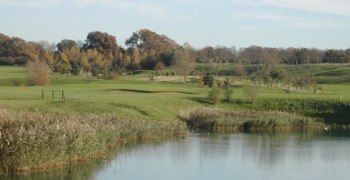
Clandon Regis Feature Review
Clandon Regis is a tranquil, peaceful golf club set over 170 acres of parkland in the Surrey countryside. Whilst it will never be considered as one of the premier golf courses in the country, it houses a varied, testing course, with doglegs demanding careful club selection and water coming into play on several holes. The course aptly uses the natural terrain and a number of man-made features to create a layout that will challenge every level of golfer.
 The course was constructed on the existing land of the Clandon Estate, located in a quiet area of Surrey but easily accessible from Woking and Guildford via the A246. The estate possessed a number of mature trees and shrubs – which have been supplemented by thousands more – ensuring, along with long, thick rough, that anything hit off line will find trouble. Whilst it wouldn’t be accurate to label Clandon Regis a hilly course, there are subtle undulations, and whilst it isn’t long, there are more than enough hazards and demanding holes to concern anyone who sets foot on the course. The club is well maintained by a team of dedicated greenkeepers who ensure there are never temporary greens, and all tees and putting surfaces conform to USGA standards.
The course was constructed on the existing land of the Clandon Estate, located in a quiet area of Surrey but easily accessible from Woking and Guildford via the A246. The estate possessed a number of mature trees and shrubs – which have been supplemented by thousands more – ensuring, along with long, thick rough, that anything hit off line will find trouble. Whilst it wouldn’t be accurate to label Clandon Regis a hilly course, there are subtle undulations, and whilst it isn’t long, there are more than enough hazards and demanding holes to concern anyone who sets foot on the course. The club is well maintained by a team of dedicated greenkeepers who ensure there are never temporary greens, and all tees and putting surfaces conform to USGA standards.
The club doesn’t possess a large-scale driving range, but there are indoor practice facilities, two practice greens, a well stocked professional shop and a large, beautifully designed clubhouse serving fine food and offering lovely views out over the treacherous, water-strewn 18th.
Par 3s
The par 3s at Clandon Regis mirror the course as a whole: they aren’t long, but you can get into difficulty if you don’t commit to hitting straight, solid shots. Water comes into play on two holes, as do tall, bushy trees waiting to catch anything hit off line.
The first of the par 3s is the second hole. It only plays around 150 yards from the whites, but there is more than enough to concern you as you contemplate your tee shot. A ditch runs diagonally across the fairway some 20 yards short of the green and then meets another, which turns right and flanks the left side of the long, narrow green. Anything slightly pulled will find the hazard or a large oak tree guarding the point where the two ditches converge. Club selection is all important on this hole, as the green - some 20 yards long – is divided in two by an extremely steep ridge. The front portion of the green is only 15 feet deep, with anything tumbling onto the lower level presenting a difficult two-putt.
The other par 3 on the front nine, the 6th, as well as the 17th, are a fairly innocuous holes, but the 12th is enough to give anyone a fright. The hole is 186 yards from the whites, with tee shots hit over a sizeable stream. Anyone with a tendency to push the ball will struggle; the carry increases significantly as the water flows diagonally across the hole from left to right. A large bunker protects the front of the green which, in itself, slopes severely from left to right. Par is an excellent score.
Par 4s
The par 4s are probably the stand out feature, and vary from short, almost driveable holes with little trouble to long, challenging par 4s with island greens, thick rough and out of bounds. The first and third hole measure no more than 350 yards and are legitimate chances for par, but the course fights back on the 4th. It measures 430 yards from the white tees, and losing a ball is a distinct possibility. A row of thick trees will punish pulled drives, and knee high rough lies in wait off both sides of the narrow fairway. A ditch dissects the fairway around the 250 yard mark as the hole swings to the left, meaning a perfect drive still leaves an approach in the region of 170 yards to a small green with a narrow entrance.
The best two par 4s on the back nine are the 14th and 18th holes. The former is a 415 yard brute and, in my estimation, the hardest hole on the course. Long, wispy rough congregates on a steep bank just off the left hand side of the fairway, with out of bounds also coming into play. Water runs all the way down the right hand side of the hole, cutting in just short of the green. Any approach hit slightly fat or pushed to the right will find a watery grave.
The finishing hole is similar in design. Drives must be moved from left to right to open up the green, but anything hit too straight will run into thick rough, and anything overworked will either end up in, or finish short of, a huge pond laden with tall reeds. The approach shot must avoid bunkers at the front and back of the green, and the best shots will utilise the terrain, which, including the green, slopes from left to right.
Par 5s
The par 5s present the best opportunity for low scoring, with only one measuring over 500 yards. As with Clandon in general, keep it in play and birdies are possible, but stray a little off line and you will be scrambling for a par.
The 5th is the first and, arguably, the best par 5 on the course. Drives play uphill and slightly left to right, with trees and thick rough both left and right. In truth, it isn’t the hardest fairway to find, but the hole narrows considerably around the 280 yard mark. Very few will be able to reach the green in two and, even if you can, it isn’t the shrewd play. Second shots have to be extremely precise to find the lay-up area, let alone the green. If not, heavy rough, a row of bushes on the left and trees on the right await. The green itself is small and well protected by sand, rough and dense bushes just off the back edge.
Seven and 11 are relatively straightforward, but the 15th is another good test. The A2456 runs the length of the fairway left, with mounds of thick rough and newly-planted trees on the right. As with the 5th, the fairway narrows considerably during the later stages of the hole. About 50 yards before the green the fairway is no more than 10 yards in width, with a large tree blocking any lay-up hit too far left. Approaches must be pinpoint accurate; anything pulled will be snagged up by the tree, and anything hit short and to the right will find one of Clandon’s many ponds.
Clandon Regis is a pleasant golf course with some varied and challenging holes. Good scores are attainable, but only if you keep your ball in play. I would give it an overall rating of 3.5/5.
Related Content:





